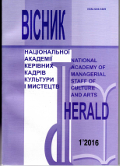LIGHT AND DARKNESS AS DEMONSTRATORS OF ETHICAL VALUES IN THE NEW TESTAMENT
DOI:
https://doi.org/10.32461/2226-3209.1.2016.138480Keywords:
light, darkness, axiology, numinous continuum, sacral anthropology,Abstract
Role of light and darkness as axiological constants from the ethical part of the New Testament was consideredin the Article. Special aspects of light/darkness presentation as instruments of sacralization and active social and cultural
regulators and correlators of numinous space were highlighted. Semantic spectrum of light and darkness image, binaryof these terms and variability of their transformations were indicated. Functions of light and darkness as elements ofsacral anthropology in religious reflection being special cultural practice were considered.
Rationale involves understanding through cultural and philosophical exegesis of religious art mechanisms,among which axiological constants have acquired special meaning – light and darkness as specific modulants of theChristian culture meaning. Determination of the light and darkness role in sacral mechanism of cultural and Christian artorganically combining with mythopoetics shall integrate basic definitions of the Christian religious doctrine to the entirebelief system of the society. The Bible includes extensive system of cultural, axiological, symbolic and iconic, metaphoricelements wherein light/darkness are the instruments of sacralization and legitimation of the model of social and Christianregulation.
Purpose of the Article is to understand axiological capacity of light and darkness as demonstrators of ethicalvalues in the New Testament. Thereunder, the following tasks were assigned: firstly, to determine dialectics of light anddarkness coexistence and special aspects of their presentation as axiological constructors and axiological demonstratorsfrom the ethical part of the New Testament; secondly, to analyze semantic meaning of light and darkness in texts of theNew Testament; thirdly, to determine morphologic function of light and darkness semantics and their role in numinousspace creation and change.
Light and darkness in the Biblical ontological dimension are hierophany "communication" elements moving ahuman closer to/away from God whereby violate demarcation between sacral and secular space. Creation of social andcultural religious space is legitimized by light as an active regulator of secular/sacral communication portal. Axiologicalcode of light is based on mythopoetic, iconic and symbolic, ontological and transcendental elements for demonstration ofnon-material nature of the God. Light is an imperative with the help of which involvement in the numinous dimension isestablished. Such involvement is expressed in grace offering to the God’s light and is symbolic and presentation basis foraxiological and cultural polycode of the Christianity predicates: firstly, modeling human’s behavior by translation of sacralintentions – ethical and Christian regulators; secondly, light sacral support – axiological attributes of numinous spacewhere a man of God is located; thirdly, a human as a cofounder of cultural and religious space of the Christian light;fourthly, light as a semantic construct of axiological, symbolic and iconic, epithet and metaphoric and mythopoeticdimensions of the Christianity.
Using a symbol of light for determination of the God’s nature extrapolates poetics of symbolism into theologicalfield. Representatives of sacral sanctions, God’s presence – axiological "derivatives" of light: luminary (in the Bible – theGod’s word, the God’s law); in hagiographical literature and Bible – luminary of the Church, saints; Gospel; angels;guardian angels, etc. Ontological modes of light and darkness are also axiological actions – active and/or passive. Lightis always active: in fighting against infernal powers, in the Christianity truth enlargement, God’s men rescue and support.Darkness, in exchange, is passive, it represents absence of light. Correlation of the darkness qualitative characteristics –from essence expression in light antipode to fighting against it, bringing to sacral sanctions and punishment of innocents,demonstrates its activity.
Therefore, the research of light and darkness axiological constructors as demonstrators of the New Testamentethical values, rethinking thereof in the cultural dimension allows determining their influence on creation of particularitiesof numinous continuum of the Christian world. Light and darkness are axiological representatives of sacral opposition to bipolar world order, active semantic and morphologic joining elements between sacral and secular space. Performingregulation function of God – human, human – God communication channel, light and darkness introduce topos – sacralinvolvement and axiological action, to cultural and religious reflection. Light and darkness as factors of social regulation –metaphoric, mythopoetic elements of sacral anthropology, correlators of ethical and humanistic units, modulators andtransformers of ontological field, specific "axiological templates" of the Christian ascetic culture, orient coordinate of thereligious genesis – participation with the Christ. Value forming potential of light and darkness is a guarantee of polycodeof semantic and multiple modification of the spiritual – hierophany.
Downloads
Published
Issue
Section
License
Authors who publish with this journal agree to the following terms:
1. Authors retain copyright and grant the journal right of first publication with the work simultaneously licensed under a Creative Commons Attribution License International CC-BY that allows others to share the work with an acknowledgement of the work's authorship and initial publication in this journal.
2. Authors are able to enter into separate, additional contractual arrangements for the non-exclusive distribution of the journal's published version of the work (e.g., post it to an institutional repository or publish it in a book), with an acknowledgement of its initial publication in this journal.
3. Authors are permitted and encouraged to post their work online (e.g., in institutional repositories or on their website) prior to and during the submission process, as it can lead to productive exchanges, as well as earlier and greater citation of published work (See The Effect of Open Access).


